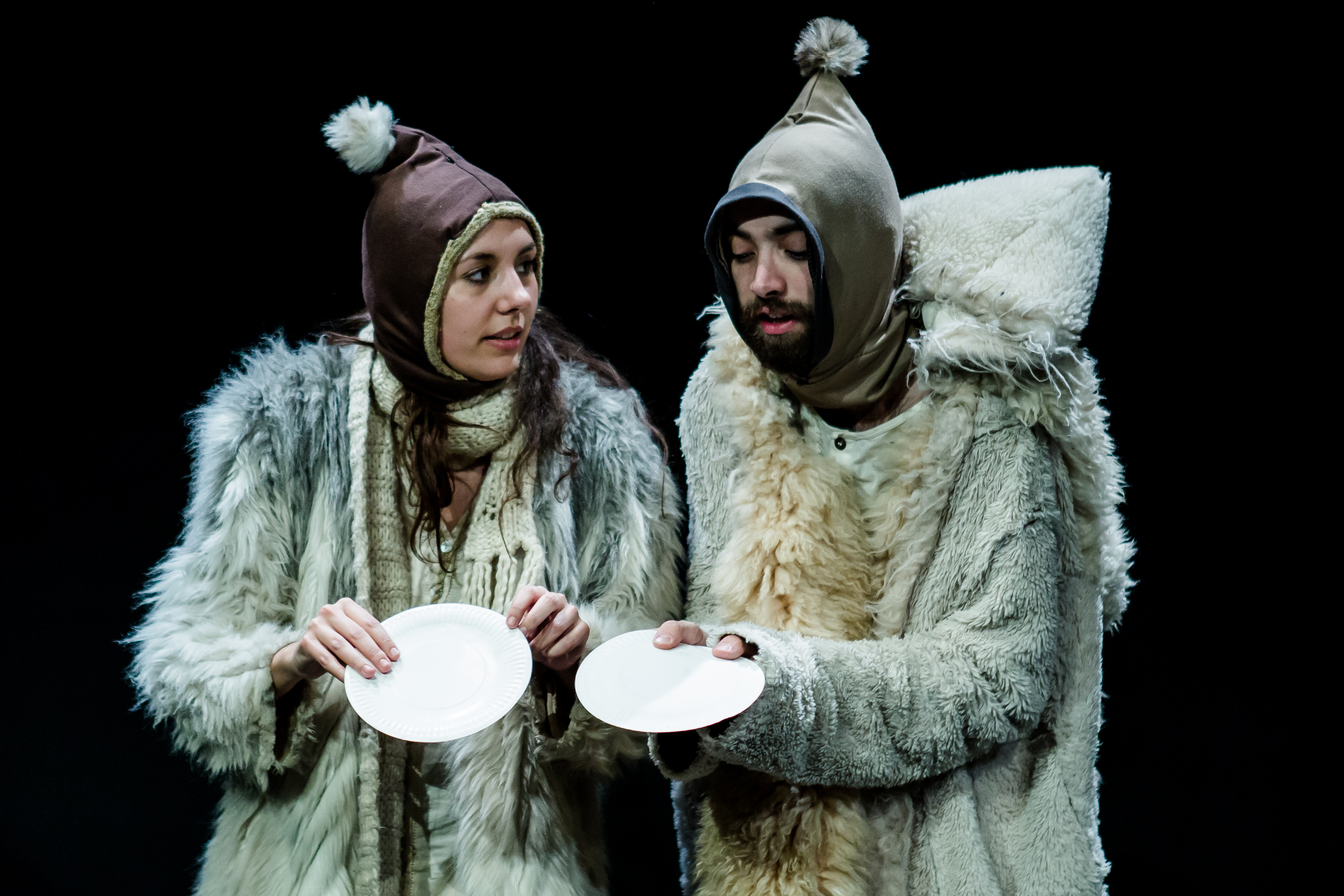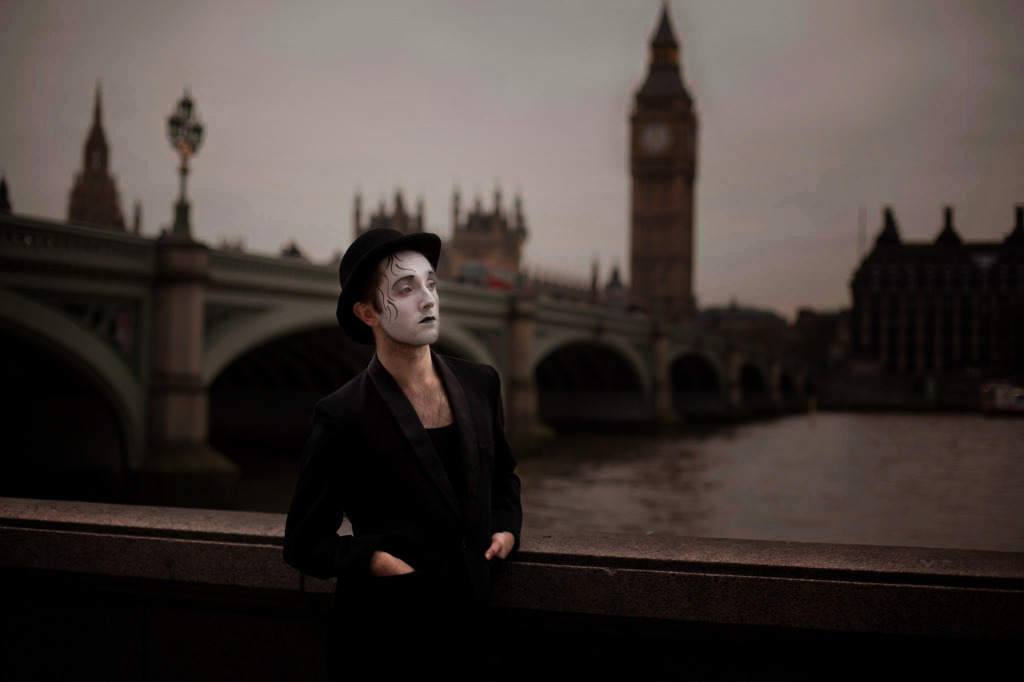SAVAGE reviews The Mimetic Festival
This year, the Mimetic Festival’s showcase of mime, puppetry, magic, cabaret and theatre took place in The Vaults, in the tunnels underneath Waterloo. Masterminded by Alex Parsonage, the two-week long festival is a celebration of performance theatre and creativity. SAVAGE is one of the festival’s awards partners, and has proudly reviewed nearly a third of the performances:
NIALL ADAMS reviews ‘Brainchild’
‘Brainchild’ is a bizarre experience. Promising a synergy of philosophy and comedy, Dan Lee’s one man show takes the form of a series of surreal sketches, ranging from a gibberish-spouting general to a lonely cowboy with only a goldfish for a friend. Particularly outlandish are the closing scenes with the Pope baptising the audience in mini-cheddars and vodka. Throughout the entire performance, audience participation is integral: not a single character passes without pulling someone up on stage or involving everyone in the theatre in some way in the piece. Most of the night’s funniest moments actually came from how the audience interacted and responded to his creations. Unfortunately, the less spontaneous sections fell flat at times. Despite the promise of ‘enlightenment guaranteed’, most laughs were drawn from slapstick humour, rather than the supposed philosophy within the piece. But if you seek some light and strange comedy, Brainchild amply delivers.
DANA MOSS reviews ‘The Misdemeanours of Saccharine’
‘The Misdemeanours of Saccharine’ certainly lived up to its promise of mixing together the likes of The Brothers Grimm and Roald Dahl to create a chilling show piece. The show loosely follows connected story lines, exploring well known fables to create an unnerving cautionary tale. The production’s greatest achievement is its use of puppetry and manipulation of props. In one tale, a version of ‘The Boy Who Cried Wolf’, a girl named Matilda repeatedly pretends her house is on fire to gain attention from her neighbours. Shown solely through paper puppets on sticks, the unsurprisingly tragic ending is not weakened by the puppetry, rather given a more sinister edge. Another story line uses characters created entirely out of hats and scarves and the manipulation of the costumes proved convincing and enjoyable; something the audience likely would not have seen before. The one criticism of the show comes from its unfinished status. There was no overlying plot line to draw the stories together, so it appeared somewhat chaotic and unstructured: something which could have been truly compelling falls short slightly from this overall lack of coherency. Throughout, the show is accompanied by live music played by the actors, creating a whimsical exterior to a truly menacing play underneath. Together with the multilingual script, leaving the audience in some confusion whilst the actors chatted away, the actors adapted powerful source material to create an overwhelming and creepy show.
ANDROULA KAFA reviews ‘Miss Glory Pearl’
Miss Glory Pearl is chubby, naked and intelligent. Whatever prejudices you enter Miss Glory Pearl’s show with, it’s certain you’ll leave without them; her stand-up is basically an all-encompassing attack on prejudice itself. A self-proclaimed feminist, she wonders what perfection really is, and asks why a woman’s body should be expected to exemplify it before it can be exposed. Asking her audience to draw a ‘circle of shame’ around their least favourite body part, she illustrates how deeply affected we all are by the silly stereotypes imposed on us. Miss Glory Pearl questions whether the human body is inherently sexual, or inherently offensive, by criticizing the absurdity and elusiveness of laws against ‘nakedness’. She objects to the gendered character of advertising and the food industry. She questions why ‘getting naked’ should be indicative of low intelligence, or lack of education; she herself, a burlesque artist and ‘naked’ comedian, has been a school teacher for most of her life. Audaciously militant yet sufficiently elegant, impressively intelligent yet hilariously entertaining, Miss Glory Pearl is a woman to look out for. Watch her show, but be warned: by the time it’s over, you’ll come to feel more naked than she actually is.
NICOLA WATKINSON reviews ‘Mummy’
Lizzie has returned to her father’s house to work on her thesis. She retires to the attic for some peace and quiet, but ends up being distracted by the remnants of the past that are stored there. The play follows Lizzie’s transition from child to adult as she finally lets go of her past and finds a direction for her future. Amy Gwilliam plays both Lizzie and Cliff (Lizzie’s imaginary childhood friend) beautifully, skilfully straddling the line between comedy and drama. Although this is still a work in progress, the performance is incredibly slick. For a show taking part in a festival which celebrates mime and cabaret, it is heavily reliant on physical theatre, but Gwilliam’s excellent sense of timing avoids this looking either sloppy or mechanical. The play is held together by contrasts – between dialogue and physical theatre, between the past and the future. It requires a sense of Lizzie’s total isolation, as well as a connection between her and the audience. It combines Shakespeare with Madonna, imaginary friends with ghosts, philosophical questions (“what happens to the dead people if you don’t believe in God?”) with the downright mundane (the best hair removal technique). It asks questions we have all asked before, and will continue to ask for as long as we are human; more than anything else, the play is a celebration of humanity.
NANCY HEATH reviews ‘On Being Yourself But Better’
Wow. Accessed through a graffitied tunnel, the Mimetic Festival has a prohibition era vibe, fantastic for the 1920s style karaoke-drag show running throughout the night in the ‘pi-bar’ before and after performances. ‘On Being Yourself But Better’ was short and truly ‘mimetic’ in its entirety. The cast of five’s cross-dressing throughout the performance brilliantly forced the audience to consider gender roles – one of the show’s main concerns. An ‘evolution of man’ sequence opened the show, depicting physically how our ancestors have risen from the ground to walking, talking, posturing…businessmen. ‘On Being Yourself But Better’ requires the audience to constantly rethink its ideas about modern consumerist society, the separate roles we herd men and women into, and the expectations of appearance we place upon them. It veered at points towards the absurd, was overall a bitingly accurate social commentary. Voiceovers of cosmetic and beauty commercials, politician’s speeches, and crude comedy sketches was an impactful but slightly chaotic start to the performance: the message was cutting and clever, but not always clear. Perhaps too many scenes were forced into too short a time to fully enjoy the intelligent satire. The finale of a dramatic birth of a watermelon baby which was promptly dropped and eaten was indicative of this: intense, but a little confusing. An interesting end to a fiercely different show.
NIALL ADAMS reviews ‘Divinely Human’
A hilarious soap opera, ‘Divinely Human’ brings a unique new twist to the conventional Christmas production. Through an impressive use of puppetry, the first act depicts the surprisingly human Christmas celebrations of the holy trinity. A bumbling elderly God, a narcissistic and pretentious Jesus, and a coarse holy ghost; these characters are not what you would expect for divinity. Crucially, they are human. They are everyone’s odd and quirky extended family members who all crawl out of obscurity around this time of year. Through a series of vignettes, the cast reflect on situations we all face during Christmas day, from arguing over parlour games, to being disappointed at presents (although in Jesus’ defence, nobody would be happy with Crocs). The entire cast has boundless energy and great comic timing, making for a wonderfully festive and hysterical piece of theatre. The second act takes the form of an abstract physical comedy exploring humanity’s everyday interactions with one another; whether this be the awkward silence of the Northern Line or attempts to introduce oneself to a stranger. Although less refined than the first act and at times losing some clarity, the second act remains hilarious and thought-provoking. The disparity in tone and style of both acts make for an interesting evening. The small cast are able to show off a versatile set of skills and all work seamlessly together to create two absolutely brilliant pieces of comedy.
NANCY HEATH reviews ‘The Boy Who Kicked Pigs’
‘The Boy Who Kicked Pigs’ is Kill the Beast’s inventive adaptation of Tom Baker’s novel. The backdrops, voiceovers, and title and end credits give the performance a cinematic quality throughout, whilst the grey make-up and costumes give the show an eerie, exciting feel. Thirteen-year-old Robert Caligari is a maniac, but at times seems like the only logical character in the show. Robert is spurred on by his own conviction and the hallucinations of Trevor-his-sister’s-talking-piggy-bank to become a famous murderer. The only thing he’s missing? He hasn’t murdered anyone. Yet. The barber-shop-quartet style songs layered throughout are fantastic, as is the cast of four’s comic timing. The only word to describe the faultless to-and-fro of Robert and his sister’s arguments is choreography: the whole show is a clever, disturbing, hilarious dance. One tragedy leads to another, and every mismatched character ends up dead in one disaster due to a pitiful mistake of Robert’s, which brings about his own demise. Humanity’s disturbing obsession with hearing terrible news is played up as the audience laughs when heads explode, the elderly burn, and our young protagonist is eaten alive on stage by ball-room dancing, anniversary-celebrating sewer rats.
DANA MOSS reviews ‘The Weatherman’
‘The Weatherman’ is a one man show which follows the endeavours of Kiki Lovechild, as he endeavours to find happiness amidst the loneliness of eternity. Tasked with controlling the weather as a means of working his way through purgatory, Kiki’s struggle to adapt to the afterlife is a reminder of the beauty of being alive. The most powerful technique used in ‘The Weatherman’ is the use of mime throughout. The audience never forgets that the performance is soundless apart from the soundtrack, but Kiki performs with such boundless energy that it does not detract from the show. Instead, it gifts Kiki with a childlike innocence and wonder at the world, which slowly deteriorates as the reality of afterlife begins to sink in. The production intelligently manipulates props and settings; creating people out of coats and broom handles, and in one beautiful moment the opening of an umbrella causes blue confetti to rain down on the audience. The audience participation of the piece is another highlight, and at one point foam planes are handed out and the audience encouraged to throw them through a hoop on stage. ‘The Weatherman’ is heartfelt and intelligent, mixing childlike wonderment and magic with the stark reality of spending eternity alone.
NIALL ADAMS reviews ‘Where the White Stops’
Imploring the audience to question the boundaries between safety and risk, complacency and exploration, Antler Theatre’s touring production makes for a fascinating experience. Following the story of Crab (Jasmine Woodcock-Stewart), a young girl dreaming of escape from the boundaries of her village into the wintry wilderness of the White, the play relentlessly takes the audience into the unknown and a barren world of mythical beasts and the deranged. Impressive performances are abundant within this cast. Woodcock-Stewart especially shines, blurring both a youthful, wide-eyed naivety with an inner strength and spunky character making for a believable and touching performance.
Yet, director Richard Perryman and the production team’s innovative ways of creating sound and visual effects are the true highlight of the piece. Music is provided, not by an orchestra, but by the actors’ own voices in polyphonic tribal chants whilst the passage of time is reflected subtly through a clever use of lighting. With wind and snow created by the actors themselves, one could expect the fantastical illusion to crack, but self-referential humour in the opening half works to establish these techniques as plausible allowing them to feel natural and authentic in the plays increasingly serious conclusion. ‘Where the White Stops’ is a truly wondrous piece of theatre. Pushing the boundaries of their limited space and budget, Antler Theatre transports the audience to a world of both beauty and desolation, always seeking the danger and wonder of the unknown and asking if this is worth it.
NICOLA WATKINSON reviews ‘Un Cas de Nostalgie’
Un Cas de Nostalgie follows the character of Pi the mime, as he travels through the land of his imagination. As he discovers different outfits and accessories, he is inspired to assume different roles, including a geisha, a stripper and a ballerina. The show is somewhat cryptic. Are these memories that Pi carries around with him? Do they represent different sides of his personality, or different people altogether? None of the questions that the show raises are answered, but perhaps that’s all part of the fun. The whole show is inevitably silent, except for some well-chosen background music to help the audience follow what role he is playing. Pi is first and foremost a dancer, with an excellent sense of timing; this is clearly a highly-choreographed and well-rehearsed performance, which is above all a comedy, meaning that his ability to keep time with the music is crucial. The show, as well as being humorous, is very touching, as Pi’s childlike excitement and wonder at the world around him begin to influence the audience too. Although it is unclear whether anything comes of Pi’s explorations – does he “find himself”? We don’t know – it is a glorious show; and perhaps one of the things Pi tries to teach us is, rather than letting the search for meaning obscure our enjoyment, to appreciate life for the magical, exciting, unpredictable thing it is.
VANYA JONES reviews ‘The Greatest Liar in All the World’
This delightful retelling of Pinocchio is a welcome departure from Disneyland. Familia de la Noche present a whimsical (although slightly disjointed) hybrid of puppetry, slap-stick, magic tricks, shadow puppets, nostalgic monologue, rapid-fire wit, and awesome live music: it’s the first time I’ve seen a one-handed man play the guitar!
We meet the adult Pinocchio, ‘The Greatest Liar in All the World’, at the end of his deceitful performing career. He confesses that the backstory we think we know is entirely fabricated, and sets out to redeem himself. Forget Jiminy Cricket’s watchful eye – poor Pinocchio was really an unplanned child, abandoned at birth. His adoptive father, Geppetto the carpenter, is in fact Jacuzzi; an impostor to whom Pinocchio’s compulive lying can be attributed.
Character development was the secret ingredient that made for such a treat. Why does this puppet boy turn into a naughty, donkey-headed liar? The answer is to win the love of the blue fairy, “a beautiful girl with celestial blue hair” (and clown makeup?). Realising that his beloved only appears when he’s in trouble, Pinocchio deliberately goes looking for it.
The moral of the story? Love is what makes us truly human, but once you’re mortal you must relearn to see the magic. Twisting the truth can cost you what you love most. But in the meantime, it’s jolly good fun: “Lying makes everything better. Lies about the past can give people hope – when they really have no hope at all! Lying allows you to paint and colour.” Truthfully spectacular.
VANYA JONES reviews ‘Pathos’
‘Pathos’ was not my cup of tea. For a piece that claimed to explore all aspects of love, it was disappointingly shallow and offensively gratuitous. It presented human attachment as egocentric and animalistic, with no room for sacrifice or forgiveness. I did not infer the play’s driving agenda – ‘Can you kill for love’ – from its title, which turned out to be a disappointing misnomer.
The play consisted of several stand-alone episodes, each portraying a different aspect of love. These episodes explored the giddy thrill of children becoming aware of gender, a laughingly stereotypical boy-meets-girl sequence of pretended disinterest, and an instructive world tour of infidelity; humanity’s global plague.
As for visual effects, the production made creative use of projected images and included a fantastically artsy black-light sequence, with glowing indigo hands dancing to an old-school French ballad. Theatrical devices such as masks, absence of dialogue, and cross-dressing painted a picture that was consolingly impersonal and yet hauntingly incriminating in its exposure of human lust.
Overall, the performance did give pause for thought – however sensual its methods and morbid its conclusions. Far from appealing to my sense of empathy however, the final episode of nudity-meets-slasher-reel evoked only nausea and I left the performance prematurely. It wasn’t worth my peace of mind to see this ‘love’s’ bitter end – not even in the name of art.
To read SOPHIE MEADOWS’ interview with the Mimetic Festival’s artistic director, Alex Parsonage, click HERE
All images credited to Mimetic 2014, unless otherwise stated.












